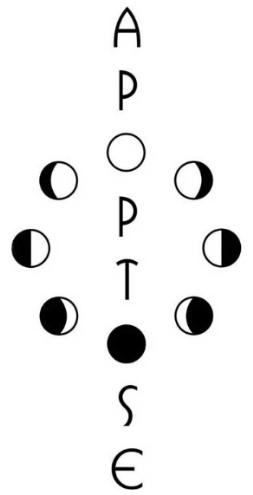

Can you remember the first time you heard or read about the Calanda celebration?
Yes, I do indeed! A friend of mine, a big industrial record collector, told me about this Vagina Dentata Organ release "The Pagan Drums of Calanda" and played it to me. This must have been back in 1991 if I remember it correctly. The sound of the drums simply struck me like a hammer. After I had listened to it for the first time I felt that I have to go to Calanda one day to get an authentic impression. It took 7 years before my dream became reality and I guess one day I'll return there for another "Semana Santa".
Have you read Kadmon's booklet "Nacht Der Stigmata - Calanda"?
I have got that Aorta issue here but I am not sure if I bought it before or after that trip to Spain. I remember that I read it shortly after the trip and found that he described feelings that were quite similar to those that I had during this event. Although I remember his report as some kind of surreal - a feeling that I didn't have at all. I found the whole event to be very real, massive and overwhelming.
Did you make some preparatory trips to Calanda before going back with the purpose to record this event?
This trip in 1998 was my first trip to Spain and the only one that led me to this little village. I wished I would have been there again just to take photos because when we were there I concentrated on the sound recording. It would have been nice to have some more photos for the CD release. I even asked Robert Ferbrache (Blood Axis) for some pictures. Michael Moynihan told me that Robert had been in Calanda about 10 years ago and took some good photos there but unfortunately he lost his in the meantime.
How did you record the celebration and what material did you use? And in which way? Did you leave the microphones open all the time near the drummers and the people involved in the celebration? Could this explain the voices one can hear in the background?
You have to imagine this as a real mass event in this village. Thousands of people are in the streets.
Most of them drumming and many just watching. The drumming is really loud! Perhaps as loud as if you
stand beside the speakers at an industrial performance. You don't recognise the voices of the people
during the event because you are so overwhelmed by the drumming. But if you record the sound it is
inevitable that you also get the voices on tape as the drummers and the watchers are all around you
talking and shouting to hear themselves over the noise. I heard them for the first time when I listened
to my recordings back home but I think they give the whole recording a more lively feeling so I didn't
try to filter them out. In the last track "Zuflucht" I even used the human voices and noises as a main
element behind the drumming.
Technically I recorded the sound with a portable DAT-recorder. The schedule of this festival is no
secret so I knew when I had to open the microphone to get some good sounds.
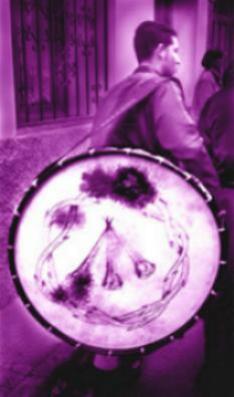
During the recording, were you aware that one day you would use these field recordings, in your music? Or just to keep a personal souvenir of this ritual?
Athough at that time my first CD "Nordland" was not more than a far away dream I was quite sure that I wanted to prepare a release with the Calanda drums. This sound was so impressive that I couldn't get away from it and I felt that I had to present it in some way or another. I never lost the thought of preparing those drum recordings. In the end it took several years before I started working on them because I didn't have the proper equipment for what I imagined to do. After Nordland was released the time was right to do something different and the drums felt different enough and just right.
How did the people react when they saw you recording the event?
I think they didn't care very much. There were camera-teams of the Spanish television that filmed and interviewed people so I wasn't very interesting for them in comparison. I just stood beside holding up my microphone.
Did you have the opportunity to participate directly in the procession? Did you manage to take place amongst the drummers?
As I tried to record as much material as I could I wasn't able to take part in the drumming although some of the villagers we got to know there offered us their drums - they had to work during the festival. When I watched the drummers I saw how much fun it was to join in those rhythms and when we go back there I'll definitely take part.
In the booklet that comes with the Blutopfer CD, one can read that the recording "(...) carries on
further what Vagina Dentata Organ began two decades ago."
Knowing that "The Pagan Drums of Calanda" album is now very hard to find, could you tell us in which way
"Blutopfer" differs from the Jordi Valls' work? What did you try to explore that this album released in
1985 had not done?
"The Pagan Drums of Calanda" features about 45 minutes of pure drumming and nothing else. There are
hardly any intervals on this record except for the one where you have to turn the LP to listen to side
2... Jordi Valls recorded this event and presented it the way it was. In the few of his interviews that
I read he gave the impression to be very much into conceptual art. This LP as well as his other aural
works were meant in some extend to provoke and to show how hollow the established music business was and
still is.
It wouldn't have made any sense to repeat this. Apoptose has a totally different aim than Vagina Dentata
Organ so I wanted to move a step further with the soundmaterial and record the music that I hear between
the sounds of the drums. The drumming makes the whole town tremble inside, not to speak of the people who
witness it. The sound is trance inducing and conjures up a lot of emotions. All that I wanted to make
hearable in the album.
"Blutopfer" is a celebration of the event itself. It investigates and brings out the effects of this old
drumming ritual to reveal the purpose that I see behind this custom. If I understand the VDO-LP correctly
Jordi Valls may have had a similar intention when he released his "Pagan drums..."-album. But we both
seem to prefer different paths to reach this goal.
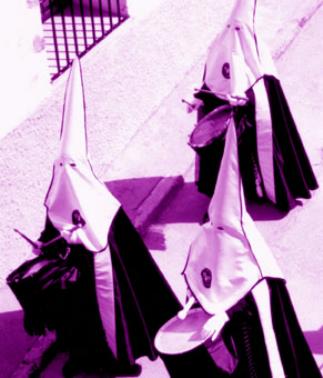
I have also heard of a tape compilation "Hallstaat" featuring Allerseelen with the title "Calanda, Nacht Der Stigmata". Have you listened to this track?
Sorry, I don't know this track. Does he use the drumming on this as well? Would be interesting to listen to his interpretation.
How did you choose amongst the hours of field recordings you brought back from your stay in Calanda?
I guess I brought back about 3 hours of recordings of different processions and rythms and other noises. In the following years I had enough time to listen to the tapes and make a decision. For the "Blutopfer"-CD I chose the tracks that impressed me most while I was recording there because of their incredible power. This feeling came back when I listened to them at home. For example the overwhelming wall of sound on "Apotropaion" which marked the beginning of the biggest event during those days and later formed into these precise rhythms. That was a stunning experience! Some of the tracks like the rhythm on "Zu Füßen der Mutter" or "Blutopfer" impressed me by their pure ceremonial grace. The rhythm on "Calanda" follows you during he whole festival because this is the main rhythm there. So all of the rhythms you hear on "Blutopfer" were on my list from the beginning - all for their own special reasons. The album wouldn't have been complete if any of them had missed.
Did you remain in touch with some of the people involved in this celebration? Have they listened to "Blutopfer"? If so, what is their opinion?
We had some contact to Calanda inhabitants but that faded away very soon so I don't know if anybody there is aware of "Blutopfer".
The famous film director, Luis Buñuel, born in the village of Calanda, said in his autobiography: "There's nothing like the sound of the drums in Calanda (...) Nowhere are they beaten with such mysterious power as in Calanda." I imagine you can only agree with this statement, can't you?
Yes, I can certainly agree with him, this sound is very special. Although there are in fact 10 or
12 villages in this area who share the tradition of public drumming during the Easter festival and
I haven't heard the drums in these surrounding villages yet. Maybe they are waiting to be discovered
by some other industrial bands in the next 20 years? I presume these villages all have their special
rhythms and processions. But what I know is that the people are all clad in different coloured robes: I
n Calanda they wear violet, in other villages it is blue or black or something else.
By the way: Two of the tracks on "Blutopfer" were recorded in front of the house where Luis Buñuel
was born...
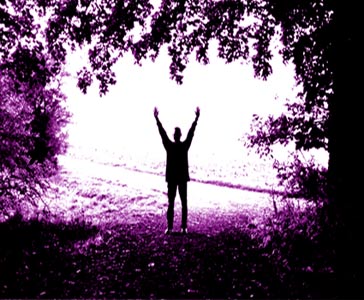
After having explored the dark part of the consciousness through a music that evokes the landscapes of the North, then the "tribute" to the special ritual of the South in Calanda, I know there are more than a few persons who are curious to discover what your next musical exploration will be. Could you give us a few indications?
Actually I have got a concept for a new album in my mind for a long time but it is far too early to talk about it because there is hardly any recording made yet. This one will not be bound to a particular geographical region. It will be in fact quite international although I guess the sound could evaluate sort of "northern" again. That seems to be my way of expression. I have got some more ideas at the moment but I am not sure if they will be suitable for a whole album. Maybe I'll do an EP in the future, too. There is no pressure for me to hurry with recordings so I just wait and see how these ideas develope and take shape.
Is it possible that, in the future, you will renew the experience of working with field recordings collected during your different travels in relation with the survival of other pagan or folk traditions?
This could happen indeed. There are certain very interesting rites in Europe that I intend to record and transform into Apoptose music. Most of these festivals are only once a year so it is not so easy to catch them but I am patient. This could be a project for a possible EP.
Thank you Rüdiger for taking the time to answer my questions. The last words are for you...
Thank you and if you happen to be in Spain during Easter time a trip to the Calanda region would be definitely worthwhile!
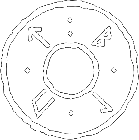
Apoptose homepage:
www.apoptose.net
Discography:
Albums: